- ALL ARTICLES
- How To Study Effectively
- Motivation & Stress
- Smarter Study Habits
- Memorise Faster
- Ace The Exam
- Write Better Essays
- Easiest AP Classes Ranked
- Outsmart Your Exams
- Outsmart Your Studies
- Recommended Reads
- For Your Students: Revision Workshops
- For Your Teaching Staff: Memory Science CPD
- Our Research: The Revision Census
- All Courses & Resources
- For School Students and Their Parents
- For University Students
- For Professionals Taking Exams
- Study Smarter Network
- Testimonials


70+ Connective Words To Power Up Your Essays [COMPREHENSIVE LIST]
by Kerri-Anne Edinburgh | Aug 5, 2021
When you’re writing an essay or assignment, you need to use every trick in the book to maximise your marks. And one of the best tools for radically improving your writing is the power of connective words .
Used correctly, connective words can give your writing new depth and meaning, improve readability (important for your examiner!) and demonstrate the logic of your arguments.
Luckily for you, we’ve got plenty of categories, definitions and connectives examples to help you get started…
Psst – this article uses loads of connectives. See if you can spot them in use: we’ve italicised the best examples!
What are connective words?
Simply put, connectives are words – or phrases – that link parts of your writing together.
You’re probably familiar with the most common connective words: and, as, because, but, if, or, so . In fact, I’ve used a few of them already – did you spot them?
Don’t limit your essay writing to the basics though, because there are hundreds of connectives that can help you to demonstrate different ideas, such as cause and effect , or the chronology of events .
We’re going to explore ten types of connectives below, but first , here’s a quick refresher on the grammar behind connective words:
Definitions: The grammatical bit
Understanding the grammar behind your writing might not be your thing – but bear with me, because remembering these six definitions will help you know which connective to use when, and where to place them!
(If you’re just looking for examples of connectives, feel free to skip straight past this bit!)
Connectives fall into three grammatical categories: conjunctions, prepositions, and adverbs.
- For example: and, but, for, or, yet .
- Today , I finished my history assignment but forgot to workout .
- Such as: at, in, of, on, under .
- I need to finish the conclusion of my essay before I go to dinner.
- For instance: upwards, quickly, fortunately .
- My deadline is tomorrow. Fortunately , I proofread my thesis chapter already .
Using adverb and preposition connective words adds specific meaning – and thus clarity – to your writing. They are particularly useful for successful essay signposting .

Definitions part 2: Connectives in sentences
When using connectives, it’s also important to remember that not all sentences are created equal in importance . And so , when connecting them into longer sentences, different types of connectives create different results:
- For example: I find French tricky but I love learning Spanish.
On the other hand,
- A subordinate clause relies on the main clause to make sense. Therefore, these connectives give information about the relationship between the clauses by specifying an order or place to events, or a cause and effect link.
- Here’s an example: I need to do my homework if I want to get a good grade .
A useful type of subordinating connective for essay writing is the:
- For instance: Firstly , I carried out the experiment, and secondly , I analysed the results.
And that’s your grammar refresh done!
If you’re struggling with essay-writing grammar, a great tool for checking your writing is Grammarly * – we use it at Exam Study Expert because it catches a broad range of mistakes. Their blog is also a great place to learn how to use conjunctions , prepositions , adverbs and more.
How to use connective words
So how do you go about using connectives?
In this section, we’re going to discuss the where, what and how …

Where to add connectives:
As we’ve seen , connective words are often found in the middle of a sentence, joining two clauses. But don’t forget you can also use them at the beginning of a sentence to link two consecutive sentences – OR two ideas within your paragraphs (did you see what I did there?).
Some of your connectives will even be linking entire paragraphs and sections – these are often examples of signposting to guide the reader through your section or argument.
What’s more , many connectives are not just single words but phrases. These connectives are particularly useful for essay writing and academic vocabulary. For example: as well as, for an example of this, for instance, in addition to, on the other hand, such as .
What to use connectives for:
When you’re writing an essay or assignment there are plenty of tasks you need to achieve: presenting evidence, making arguments and more.
Happily, connectives can help you achieve all these tasks by clarifying your meaning. You can use connectives for:
- Reinforcing or emphasising a point
- Exemplifying and showing results
- Comparing and discussing points of view
- Constructing a timeline or sequence of events
- Listing points (and signposting them)
- Explaining your argument
- Drawing together conclusions
It’s a long list! So master using connectives and you’ll drastically improve the readability of your writing across all sections of your essay.
How to add in useful connective words:
You’re probably already using basic connectives in your writing.
But if you want to get serious about the benefits to your grades, make sure you’re systematic about how you add them during your essay construction – and (later) proofreading to check they make sense on a large(r) scale!
From experience, I would suggest that the best method for choosing and adding effective connectives is to:
- Sketch out a rough draft of your paragraph or essay section
- Are they separate arguments for the same thing? Or opposite points of view? Do they follow on logically (cause and effect) or chronologically?
- Mark where you want to add signposting connectives to indicate structure
- Check your examples of connective word types and choose options that convey the meaning you need…
And for that purpose, we’ve compiled four lists of connective words for you – including the TOP 70 connectives for effective essay writing! So read on…
Free: Exam Success Cheat Sheet
My Top 6 Strategies To Study Smarter and Ace Your Exams
Privacy protected because life’s too short for spam. Unsubcribe anytime.
Types of connective words
So let’s get down to the really useful stuff: examples of connectives you can use in different situations in your essays!
There are three main types of connectives that we’re going to explore in turn:
- Comparative , Causal, and Temporal
Comparative connective words
These helpful words and phrases are perfect both for comparing similarities in data and arguments, and for pointing out their differences and oppositions. Use them to compare, discuss and argue.
When comparing points, you’ll often be adding to your argument, so these connectives are used for “ addition ”. The most common connectives for addition are: and, also, furthermore, moreover .
Here are some examples in practice:
- Leonardo Da Vinci was an artist and inventor, and also an influential Renaissance humanist.
- Exam Study Expert’s psychologist William offers expert one-on-one exam coaching . Furthermore , you can sign up for a free introductory session!
- My empirical data demonstrates that … ; similarly , theoretical models projected …
On the other hand , you might need to demonstrate and contrast your argument with the opposing point of view with a connective for “ opposition ”. The most commonly used are: alternatively, except, however, unless .
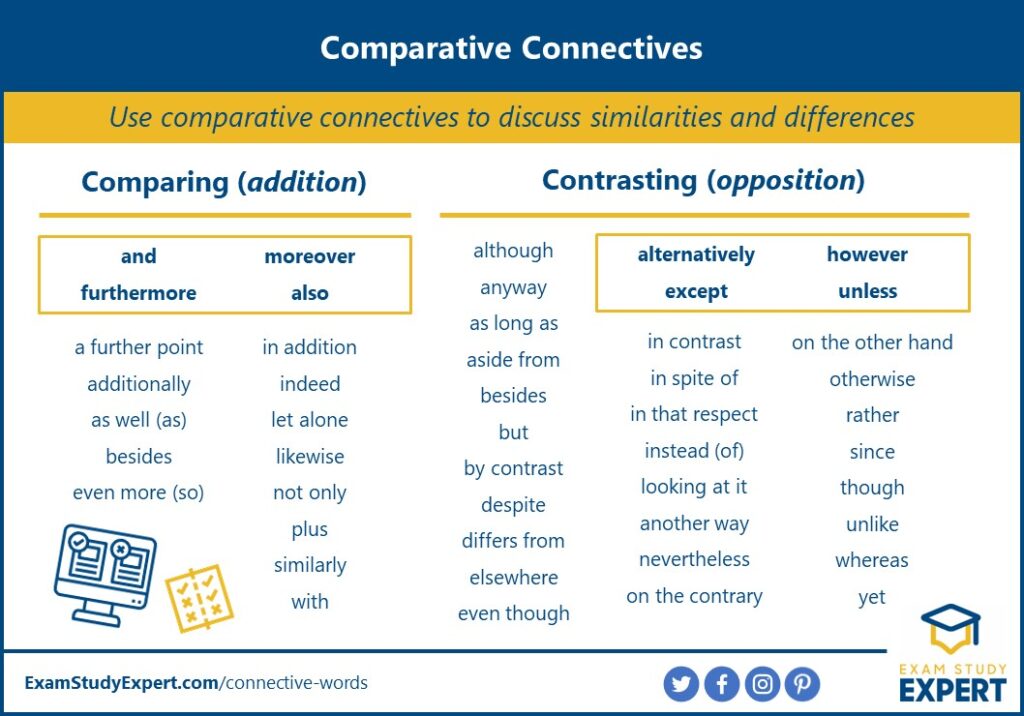
These examples all demonstrate opposition:
- Winston Churchill is best known for his wartime leadership of the United Kingdom, yet he was already in his 60’s when he took office.
- Some students find great study motivation from starting the day with their hardest task. In contrast , others find getting the ball rolling with smaller tasks more effective.
- Our first questionnaire was comprised of six questions. However , for our second questionnaire we …
Causal connective words
Causal connectives are effective for discussing cause and effect – relationships that have logical links that you want to point out and prove.
As such , academic writing is often full of causal connectives, and many of them demonstrate a very academic vocabulary (great for bonus points in your assignment!).
Most essays and assignments have a section (or several sections!) where you need to draw together your facts, ideas and arguments and point out the connections. These are the connectives to turn to at those moments!
The most commonly used are: as such, as a result (of), because, consequently, therefore, thus .
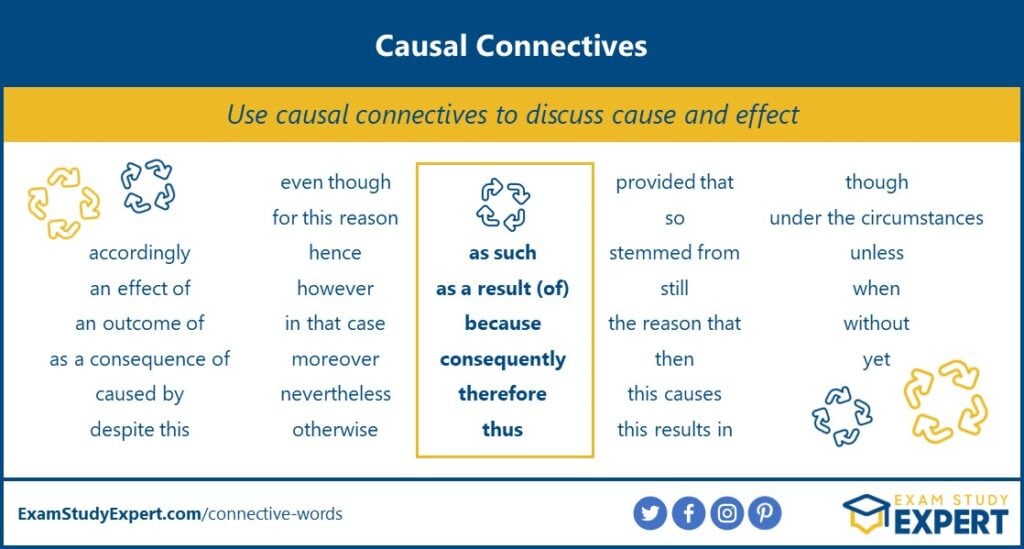
Here are some examples:
- The brains of London taxi drivers have a larger than usual area that deals with memory because they are required to memorise and navigate thousands of streets.
- Flashcards are a highly effective learning and memory tool, provided that you use them correctly.
- This study surveyed over 3,000 students. As a result , we were able to …
Temporal connective words
Whether you’re explaining the sequence of events that led to a historical battle, or demonstrating the steps in your experiment, temporal connectives are a highly valuable tool.
They’re all about discussing time and the chronology of events – what happened before, during and after . Therefore , they make for great signposting words too!
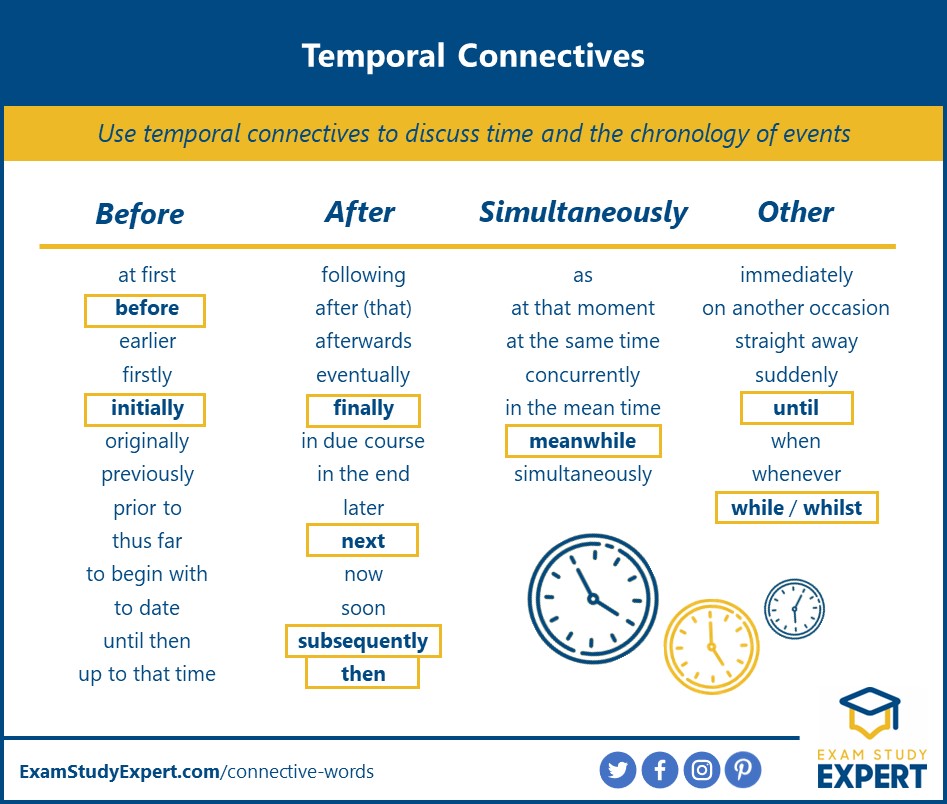
These examples explore each of the four sections in our temporal connectives lists:
- The law of gravity was not widely understood until it was mathematically formulated by Sir Isaac Newton in 1687.
- If you’re stressed about your exams, mindful meditation can be a great help. At the same time ,an inspirational quote might give you the boost you need!
- Initially , the experiment was expected to demonstrate … Eventually , we came to the conclusion that …
The TOP 70 connective words for effective essay writing!
To make sure that you’ve got the tools you need to improve your grades, we’ve compiled this epic list of all the best connectives to use in academic writing.
This is just a selection from the hundreds of connective words and phrases available. So there’s no need to make your essay stale by over-using the same one or two!
If there’s nothing else you grab when you’re ticking off Step #4 from the connectives methodology above – make sure you grab this list!
It covers all the stages of essay structuring and writing, from introduction to conclusion . And includes lists of connectives for:
- Signposting and listing
- Comparing and contrasting
- Illustrating your findings
- Demonstrating cause and effect
- Emphasising points
- Qualifying your arguments
We’ve highlighted the best and most commonly used connectives for each section to ensure you’ve got THE best resource to improve the quality of your essay immediately.

To finish off , here are some examples to get your essay-writing inspiration flowing:
- Firstly , it is well-known that retrieval practice is an effective learning method as compared with re-reading study texts and notes.
- I’m feeling tired tonight. Nevertheless , I must finish my homework and I want to take the dog for a walk.
- When it comes to …, however , there are several effective methods to …, in particular , …
Good luck with your essay!
Now you’ve mastered adding effective connective words to your essay you’re ready for the next step. Be sure to check out our guide on proofreading your assignment before you hand it in. Good luck!
And for more expert, science-backed study resources, sign up to the Exam Study Expert newsletter right here:
The Science Of Studying Smart
Download my free exam success cheat sheet: all my #1 must-know strategies to supercharge your learning today.
Your privacy protected. No spam. Unsubscribe any time.
** Please note : Grammarly is one of very few products we’re sufficiently enthusiastic about to recommend to our Exam Study Expert readers, and we may earn a small commission if you sign up to Grammarly services through the above link.
- Latest Posts
- [2024] Are AP US Government & Politics and AP Comparative Government and Politics Hard or Easy? Difficulty Rated ‘Quite Easy’ (Real Student Reviews + Pass Data) - 5 Jan 2024
- [2024] Is AP Human Geography Hard or Easy? Difficulty Rated ‘Quite Easy’ (Real Student Reviews + Pass Data) - 5 Jan 2024
- [2024] Is AP Microeconomics Hard or Easy? Difficulty Rated ‘Quite Easy’ (Real Student Reviews + Pass Data) - 5 Jan 2024
such an informative blog for the aspirants who are preparing for any exams
Submit a Comment Cancel reply
Your email address will not be published. Required fields are marked *
This site uses Akismet to reduce spam. Learn how your comment data is processed .
Read My Test-Taking Technique Book For More Marks In Exams

Top Picks: Recommended Reading From The Blog
How To Study Effectively : Ultimate Guide [READER FAVOURITE]
Exam Memorization Secrets
Inspirational Exam Quotes
Finding The Perfect Study Routine
Pomodoro Method : 9-Step Guide
Best Books About Studying
Listen To The Podcast

- Grammar Lessons
- Grammar Exercises
- Grammar Quizzes
- Mixed Tests
- PDF Worksheets
- Beginners Lessons
- Easy Worksheets
- Beginners Tests
- Reading Exercises
- Drag & Drop Grammar
- English For Kids
- Kids Word Games
- Picture Vocabulary
- Reading Tests
- Short Dialogues
- Short Sentences
- Closest in Meaning
- Irrelevant Sentence
- ESL Paragraphs
- GRE Reading
- Text Completion
- GRE Equivalence
- SAT Sentence
- Essay Writing
- Vocabulary Exercises
- Study Skills Tips
- Drag & Drop Vocab
Connectives List


- TEFL Internship
- TEFL Masters
- Find a TEFL Course
- Special Offers
- Course Providers
- Teach English Abroad
- Find a TEFL Job
- About DoTEFL
- Our Mission
- How DoTEFL Works
Forgotten Password

Linking Words & Connector Words: Ultimate List With Examples
- Learn English
- James Prior
- No Comments
- Updated February 23, 2024

Linking words and connector words are essential tools for effective communication and writing. They play a crucial role in connecting ideas, enhancing coherence, and guiding the flow of information. Whether you’re writing an essay, giving a presentation, or engaging in a conversation, using appropriate linking words can greatly improve the clarity and effectiveness of your message.
In this ultimate list of linking words, we have compiled a comprehensive collection of linking words along with examples to help you understand their usage and apply them in various contexts. From words that highlight contrast and similarity to those that indicate cause and effect or order of importance, this list covers a wide range of linking words to suit different purposes.
Ready to link your words? Let’s get started!
Table of Contents
What are linking words?
Linking words, also known as connector words or transition words, are words or phrases that connect ideas or parts of a text, providing coherence and smoothness to the overall flow of information. They serve as bridges between sentences, paragraphs, or even larger sections of a document, helping to establish relationships, indicate contrasts, add information, show cause and effect, provide examples, and more.
Here are some common categories of linking words with examples:
Linking words for addition
Addition: Words that show the addition of information or ideas.
These linking words and phrases can help you add information, reinforce ideas, or provide further examples in your writing or conversation. Use them appropriately to expand on your points and enhance the overall coherence and richness of your communication.
- She is fluent in English, and additionally, she speaks French and Spanish.
- The report highlights the benefits of renewable energy; furthermore, it emphasizes the importance of conservation.
- The new system not only improves efficiency but moreover, it reduces costs.
- In addition to his regular job, he volunteers at a local charity.
- She not only excels in academics but also actively participates in extracurricular activities.
- The team consists of experienced professionals as well as enthusiastic newcomers.
- The company values teamwork; likewise, it fosters individual growth and development.
- Besides working full-time, he manages to pursue his hobbies and spend time with famil
- The website offers free shipping; what’s more, customers can enjoy a 30-day money-back guarantee.
- On top of their regular duties, employees are encouraged to take part in professional development opportunities.
- Developing strong interpersonal skills is equally important as acquiring technical knowledge.
- The event attracted a large audience, not to mention the media coverage it received.
- Along with the new software update, customers will also receive enhanced customer support.
- The company achieved its sales targets for the year; what is more, it surpassed them by 20%.
- The team completed the project ahead of schedule; besides that, they received positive feedback from the client.
- The company’s commitment to quality, coupled with its competitive pricing, sets it apart from its competitors.
Linking words for contrast
Contrast: Words that highlight differences or contrasting ideas.
These linking words and phrases can help you express contrasting ideas and show the differences between two or more concepts or situations. Remember to use them appropriately based on the context and your intended meaning.
- She studied hard; however, she didn’t pass the exam.
- John loves traveling; on the other hand, his sister prefers staying at home.
- The weather was terrible; nevertheless, they decided to go for a walk.
- He had a sprained ankle; nonetheless, he played in the soccer match.
- Despite the rain, they went to the beach.
- In spite of the traffic, they arrived on time.
- Although it was late, they continued with their work.
- Even though she was tired, she went to the gym.
- I enjoy reading, while my brother prefers watching movies.
- Sarah loves cooking, whereas her husband prefers eating out.
- Unlike his friends, Mark is not a fan of horror movies.
- She hates winter; conversely, I love it.
- She expected him to be upset; on the contrary, he was happy.
- They planned to go to the cinema, but instead, they stayed home and watched a movie.
- The cat is small and playful, in contrast to the dog, which is big and lazy.
- He enjoys sports; conversely, his sister prefers art.
- On one hand, the book is interesting; on the other hand, it’s quite lengthy.
- They could go by car, or alternatively, they could take the train.
- The movie received mixed reviews; nevertheless, it became a box office hit.
- She didn’t pass the test, but in any case, she learned a lot from studying.
Linking words for similarity
Similarity: Words that highlight similarities or shared ideas.
These linking words and phrases can help you express similarities between two or more ideas, situations, or individuals. Use them appropriately based on the context to highlight shared characteristics or experiences.
- Sarah enjoys reading; likewise, her brother is an avid reader.
- John and Emily both love hiking; similarly, they enjoy spending time in nature.
- Just as Sarah likes swimming, in the same way, her best friend enjoys diving.
- Jack has a passion for photography, similarly to his sister who is also an enthusiast.
- Just like her mother, Jane has a talent for playing the piano.
- The two artists approach their work in a similar vein, both using vibrant colors and bold brushstrokes.
- Mark loves cooking, and by the same token, he also enjoys experimenting with new recipes.
- As the workload increased, the stress levels of the employees correspondingly rose.
- Both Sarah and Emily are equally skilled in playing the guitar.
- The designer creates unique clothing pieces, and in a similar fashion, the jewelry maker crafts one-of-a-kind accessories.
- Just as the sun rises in the morning, the moon appears in the evening.
- The teacher explains complex concepts in a simple and understandable way, in the same manner as her colleague.
- He enjoys hiking and camping, and his friends, likewise, too, share his enthusiasm for outdoor activities.
- Just as a bird builds its nest with care and precision, in the same way, an architect plans and constructs a building.
- The two books explore themes of love and loss, along similar lines, inviting readers to contemplate the human experience.
- As with all great artists, Picasso’s work continues to inspire and influence generations.
- Exercise is essential for physical health, and just as importantly, it is crucial for mental well-being.
- Much like a puzzle, life consists of various pieces that fit together to form a bigger picture.
Linking words for cause and effect
Cause and Effect: Words that demonstrate cause and effect relationships.
These linking words and phrases can help you express the cause-and-effect relationship between events or actions. Use them appropriately based on the context to convey the reason and result of a particular situation or occurrence.
- He failed the exam because he didn’t study.
- They arrived early since they left home on time.
- As a result of heavy rainfall, the streets were flooded.
- The event was canceled due to bad weather conditions.
- The store was closed, therefore, they had to find another place to shop.
- He missed the train, consequently, he arrived late to the meeting.
- Owing to a power outage, the concert was postponed.
- She didn’t have enough sleep, thus, she felt tired throughout the day.
- He couldn’t attend the party, for this reason, he sent his apologies.
- The storm caused damage to the houses, resulting in the need for repairs.
- The baby was hungry, so she started crying.
- Lack of exercise and poor diet often leads to weight gain.
- They missed the train because of heavy traffic.
- The roads were icy, this is why there were many accidents.
- They spent all their money, as a consequence, they couldn’t afford the trip.
- He quit smoking, and since then, he feels healthier.
- The company introduced a new product, and in turn, its sales increased.
- She studied hard so that she could pass the exam.
Linking words for time and sequence
Time and sequence: Words that indicate time or sequence of events or actions.
These linking words and phrases can help you express the chronological order and sequence of events or actions. Use them appropriately to guide your audience through the progression of ideas or to outline the steps in a process or narrative.
- Firstly, let’s discuss the main causes of climate change.
- Secondly, we need to consider the potential solutions to the problem.
- Next, we will move on to the implementation phase of the project.
- We need to complete the research phase first. Then, we can start analyzing the data.
- After that, we can proceed with the construction of the building.
- The company experienced financial difficulties. Subsequently, they had to lay off several employees.
- The team was working on the project. Meanwhile, the marketing department was preparing the promotional materials.
- The two processes are happening simultaneously, ensuring efficient production.
- The report will be ready in a week. In the meantime, please proceed with the other tasks.
- During the meeting, we will discuss the budget and timeline.
- While he was studying, his friends were playing video games.
- Please wait here until your name is called.
- We need to complete the paperwork before the deadline.
- She attended the conference, and afterward, she shared her insights with the team.
- Finally, we reached an agreement after a long negotiation process.
- In the end, they decided to cancel the project due to budget constraints.
- The presentation was engaging, and at the same time, informative.
- Initially, he struggled with the new software, but with practice, he became proficient.
- At first, the project seemed overwhelming, but with proper planning, it became manageable.
Linking words for order of importance
Order of Importance: Words that highlight the hierarchy or ranking of ideas based on their significance.
These linking words and phrases can help you establish the order of importance when presenting ideas or arguments. Use them to emphasize the significance of certain points, highlight key considerations, or guide the reader’s attention to the most critical aspects.
- Most importantly, we need to prioritize the safety of our employees.
- Above all, we must prioritize the needs of our customers.
- The company’s success primarily depends on effective leadership and strategic planning.
- First and foremost, we need to address the urgent issue of inflation.
- The new policy chiefly focuses on reducing waste and promoting sustainability.
- Notably, the project resulted in significant cost savings for the organization.
- Above anything else, maintaining a high standard of quality is our top priority.
- It is essential to note that effective communication is the foundation of strong relationships.
- It is worth mentioning that the company’s ethical practices have earned it a positive reputation.
Linking words for exemplification
Example: Words that provide examples or illustrate a point.
These linking words and phrases can help you introduce examples and provide further clarification or evidence to support your statements. Use them to enhance your explanations and illustrate your points effectively.
Here’s a list of linking words and phrases that are commonly used to illustrate an example, along with examples:
- There are many fruits you can choose from, for example, apples, oranges, and bananas.
- Many countries have implemented environmental policies; for instance, Sweden has significantly reduced its carbon emissions.
- I enjoy outdoor activities such as hiking, cycling, and swimming.
- The party was attended by several guests, including friends, family, and colleagues.
- He has many hobbies, like painting, playing the guitar, and photography.
- The company provides various employee benefits, as an illustration, health insurance, retirement plans, and paid time off.
- Let me give you an example to illustrate my point.
- There are several endangered species in the area, namely the African elephant, the Bengal tiger, and the giant panda.
- The city offers various attractions, in particular, museums, parks, and historical landmarks.
- The project requires specific skills, specifically programming and data analysis.
- By way of example, let’s consider the case of a successful startup that disrupted the market.
- To give an example, let’s say you want to improve your fitness; you can try activities like jogging, swimming, or joining a gym.
- The experiment was conducted to demonstrate the effects of temperature on plant growth.
- As a case in point, many countries have implemented renewable energy initiatives to combat pollution.
- I will use a specific scenario to exemplify how the new policy can be implemented effectively.
- The job requires strong communication skills , in essence, the ability to express ideas clearly and persuasively.
- The city has invested in renewable energy projects to reduce its carbon footprint. One example of this is the installation of solar panels on public buildings.
- To be specific, the company offers three main product lines: electronics, appliances, and furniture.
- The data collected serves as proof that the new marketing strategy is effective.
- In a similar manner, many companies have embraced remote work as a response to the pandemic.
Linking words for focusing
These linking words and phrases can help you direct attention or emphasize a specific aspect of your discussion or argument. Use them appropriately to highlight the main points or focus areas, ensuring clarity and precision in your communication.
Here’s a list of linking words and phrases that are commonly used to express focusing or directing attention, along with examples:
- Specifically, we need to address the issue of employee turnover in our department.
- The marketing team has made significant progress, particularly in digital advertising.
- In particular, we need to improve our customer service to enhance customer satisfaction.
- Notably, the company achieved a record-breaking sales figure in the last quarter.
- This task requires attention to detail, especially when dealing with sensitive data.
- Specifically speaking, the new software update addresses the security vulnerabilities.
- Above all, we must prioritize the safety of our employees.
- The company’s success mainly relies on customer satisfaction and brand reputation.
- The primary goal of our project is to reduce waste and promote sustainability.
- Essentially, our focus should be on optimizing operational efficiency.
- Individually, each team member plays a crucial role in achieving our objectives.
- Precisely, we need to adhere to the project timeline to meet the deadline.
- Specifically, with regards to customer feedback, we have received positive reviews.
- The new product line has a sleek design, not to mention its advanced features.
- It is worth noting that the market trends are shifting towards online shopping.
- Above everything else, we need to prioritize the quality of our products.
- In essence, our primary objective is to provide exceptional customer service.
- To be more precise, we should focus on improving our supply chain management.
- In specific terms, the sales team needs to focus on building client relationships.
- More importantly, we need to address the concerns raised by our customers.
Linking words for conclusion
Conclusion: Words that summarize or conclude a text.
These linking words and phrases can help you signal the conclusion of your argument, presentation, or essay. Use them to summarize key points, restate your main argument, or provide a final thought or recommendation.
- In conclusion, it is evident that deforestation poses a significant threat to our planet.
- To sum up, the project was a great success, exceeding all expectations.
- Ultimately, the decision lies in your hands.
- All in all, it was a memorable vacation filled with adventure and relaxation.
- Lastly, I would like to thank everyone for their hard work and dedication.
- In summary, the findings of the study suggest a strong correlation between exercise and mental well-being.
- To conclude, the evidence supports the hypothesis that regular exercise improves cardiovascular health.
- The data collected consistently points to the same conclusion; therefore, we can confidently assert our findings.
- In essence, the research demonstrates that social media has a profound impact on interpersonal relationships.
- The campaign received widespread support, and as a result, donations increased significantly.
- In a nutshell, the project aims to promote sustainability through renewable energy initiatives.
- The experiments consistently yielded similar results; thus, we can draw a definitive conclusion.
- The evidence strongly suggests a link between smoking and lung cancer; hence, it is crucial to raise awareness about the risks.
- In light of these findings, it is necessary to reconsider the current educational policies.
- The company faced financial challenges, and consequently, had to downsize its workforce.
- In conclusion, it can be stated that effective communication is the key to successful teamwork.
- Taking all factors into account, it is clear that globalization has both positive and negative consequences.
- The lack of investment resulted in decreased productivity, as a consequence, the company experienced a decline in profits.
- The study findings reveal a correlation between stress levels and sleep quality; thus, it can be inferred that managing stress positively affects sleep.
- Given these points, it is evident that the project should be prioritized for its long-term benefits.
If you’d like more examples, check out this list of other ways to say in conclusion .
Conclusion: Ready to link your words?
These are just some examples of linking words, and there are numerous other linking words and phrases available for different purposes and contexts. Using them appropriately can greatly enhance the clarity and coherence of your writing or speech. So, if you want to become more fluent in English, it’s time to start thinking about linking words!
- Recent Posts
- What Can You Do with a TEFL Certificate? - April 5, 2024
- 19 Best Learning Management System Examples for 2024 - April 4, 2024
- How to Study While Working: 11 Tips for Working & Studying - March 29, 2024
More from DoTEFL

Jameses, James’s or James’? Which is Correct?
- Updated February 17, 2023

47 Online Timers for the Classroom
- Updated October 28, 2023

Cause and Effect: Definition, Meaning and Examples
- Updated November 2, 2023

11 Best Language Exchange Apps & Websites (2024)
- Updated January 18, 2024

What TEFL course should you take? What to look out for!
- Updated November 23, 2022
- The global TEFL course directory.
You are using an outdated browser. Please upgrade your browser or activate Google Chrome Frame to improve your experience.
Connectors in English: How to Use Them to Make Your English Flow Beautifully
Are your essays in English marked poorly despite your grammatically correct sentences?
Have you ever been told that your paragraphs don’t connect to each other even though they talk about the same topic?
This is where English connectors come in—a.k.a., the words I’ve marked in bold above!
Today, I’m going to talk about what connectors in English are, the most common ones you’ll come across and how to practice them.
Once you’re done with this article, I hope you’ll agree that these words and phrases are simply magical!
What Are English Connectors?
English connectors for cause and effect, english connectors for illustration, english connectors for emphasis, english connectors for comparison, english connectors for contrast, english connectors for sequence, english connectors for conclusion, tips for practicing english connectors, and one more thing....
Download: This blog post is available as a convenient and portable PDF that you can take anywhere. Click here to get a copy. (Download)
English connectors are little words and phrases that help you connect sentences, paragraphs and ideas. Used both in spoken and written English, they help make your English sound more logical and structured.
You can think of connectors as like the thread that holds a necklace’s beads (i.e. sentences, paragraphs and ideas) together.
In fact, you probably already use them without even realizing it!
Note that English connectors are different from English conjunctions . While conjunctions link two or more words or clauses within a sentence, connectors establish that two separate sentences or ideas are related to each other.
To help you understand further, I’m going to walk you through some of the most common connectors in English and how they’re used. Some are used formally, while others are more casual. Some are even interchangeable —that is, you can use them in place of similar words.
In everyday conversations , we often need to explain things.
Perhaps you were late for school because your car ran out of gas. Or you want to buy chocolates because you want to surprise your mother on her birthday.
Explaining things will be much easier if you throw in these important English connectors.
Let’s take a look at them!
Giving illustrations or examples helps us prove our point and convince other people to believe us. These words help people understand what you’re trying to say and can help them see why you believe what you believe.
While discussing an issue or idea, you may want to focus on a particular point or example. To make the listener understand the importance of that specific idea, you can use the following connectors.
Sometimes, we need to draw attention to certain similarities to make a point or explain something. This is especially important in writing!
To make better comparisons, use the following English connectors.
Sometimes, we need to express different or contradicting ideas side-by-side. Doing this helps the listener or reader focus on important differences and makes them aware of the many sides of a topic.
These connectors are useful when you’re giving step-by-step instructions or listing points.
Finally , how do you let your reader know that you’ve reached the end? (See what I did there?)
There are certain connectors that we usually use during conclusions or when we’ve reached the end of what we wanted to say. When writing or stating conclusions, you usually repeat the most important points.
Here are some quick tips that’ll help you learn English connectors more efficiently.
Make Your Own Sentences
To explain the meanings and uses of different connectors, I’ve provided example sentences for each. However, you’ll remember them much better if you come up with your own examples.
You can start by using connectors in your diary entries, notebooks, essays and the like. Soon, you’ll find yourself using these connectors in everyday speech as well!
Write a Short Story or Essay
To see the huge difference English connectors can make, try writing a paragraph without any connectors and then rewrite it using some of the connectors above. You’ll quickly realize that your sentences will flow better, sound more logical and become easier to understand.
Learn English with Authentic Content
You probably want to speak English like a native (or at least try to). So why not learn from natives? Try watching a speech in English to get a good idea of how these fit together. Look for the ones with transcripts that you can write notes in, maybe even circling all of the connecting terms as you see them.
FluentU takes authentic videos—like music videos, movie trailers, news and inspiring talks—and turns them into personalized language learning lessons.
You can try FluentU for free for 2 weeks. Check out the website or download the iOS app or Android app.
P.S. Click here to take advantage of our current sale! (Expires at the end of this month.)

Try FluentU for FREE!
Do Online Exercises
Finally, to check whether you’ve understood how to use connectors correctly, you can try online exercises from websites that cover English grammar .
For example, the ones on English Daily and English Grammar are pretty short and can be completed in a few minutes.
There’s also ToLearnEnglish , which provides a brief list of common connectors before you solve the exercise, making it a great resource for review.
Now that you know the most commonly-used English connectors, you can use them in sentences and paragraphs with great confidence. Try your hand at some of the exercises I’ve suggested for practice.
So what are you waiting for?
Get out there and start incorporating these useful English connectors into your everyday life!
If you like learning English through movies and online media, you should also check out FluentU. FluentU lets you learn English from popular talk shows, catchy music videos and funny commercials , as you can see here:

If you want to watch it, the FluentU app has probably got it.
The FluentU app and website makes it really easy to watch English videos. There are captions that are interactive. That means you can tap on any word to see an image, definition, and useful examples.

FluentU lets you learn engaging content with world famous celebrities.
For example, when you tap on the word "searching," you see this:

FluentU lets you tap to look up any word.
Learn all the vocabulary in any video with quizzes. Swipe left or right to see more examples for the word you’re learning.

FluentU helps you learn fast with useful questions and multiple examples. Learn more.
The best part? FluentU remembers the vocabulary that you’re learning. It gives you extra practice with difficult words—and reminds you when it’s time to review what you’ve learned. You have a truly personalized experience.
Start using the FluentU website on your computer or tablet or, better yet, download the FluentU app from the iTunes or Google Play store. Click here to take advantage of our current sale! (Expires at the end of this month.)
Enter your e-mail address to get your free PDF!
We hate SPAM and promise to keep your email address safe

- Academic writing
- Commonly confused words
- Critical thinking
- PEEL Paragraphs
- Linking/transition words
- Paraphrasing
- Proofreading
- Terms and definitions
- Action Words: What is description, application, analysis and evaluation
Linking/transition words: Things you need to know...
All assignments are written in formal language. You need to ensure that you demonstrate your knowledge and understanding alongside your ability to answer the question/solve the problem.
Below are some ideas to help you to develop your structure and flow.
- Linking / transition words and phrases join ideas, sentences and paragraphs together. They should be used within sentences and to move from one idea to another (between sentences).
These words and phrases indicate the direction, order and flow of ideas. Significantly, they strengthen the quality and structure of your work.
- Redundant Words - less is more. P articularly when trying to reduce the word count, it is important to look for phrases which can be replaced with a single word.
Linking/Transition Words
Transitions link one main idea to another separated by a semi-colon or full-stop. When the transition word is at the beginning of the sentence, it should be followed by a comma:
Among other functions, they can signal cause and effect or sequencing (see examples in the table below).
Linking words: conjunctions
Linking words within a sentence are referred to as coordinating conjunctions. Do not worry about the term: think about the function.
Conciseness / redundant words
Microsoft Word now has an additional feature within the Edito r - it is called conciseness or wordiness.
- If you cannot see the Editor menu a quick tip is to hold down the function (fn key at the bottom left of the keyboard) + F7 (top line of keys).
- From the Refinements section - select Conciseness - if there are any suggestions a number will appear in the box alongside this option
- A dotted line will appear under any groups of groups
- Either select the identified text by clicking with your right mouse button OR click on the down down next to the Conciseness menu.
- MS Word will display any alternative words which you can either select and they will be replaced in your text or reject if you want to keep the original phrases.
Examples: try to replace phrases with a single words which mean the same.
Need to know more...
- Related pages
- External links
- Academic writing Illustrates the main features of academic writing so that you are aware of what it is and what it involves
- Critical Thinking Academic work involves thinking, not just accepting what you read or are told.
- Terms and Definitions Important words appear in your assignments and examinations. The aim of this factsheet is to help you to fully understand what they mean.
Additional resources to help you to improve your confidence and grades:-
- Writing Effectively demonstrates the importance of: clarity, structure, relevance, argument and precision.
- Writing Mechanics gives further examples and resources on areas including: sentence structure, vocabulary, spelling, punctuation and grammar.
Linking/Transition words - Scribbr https://www.scribbr.co.uk/syntax/transition-words-examples/ [Accessed 10 February 2023]
There are many books concerning academic writing, look around Dewey number 808
- << Previous: PEEL Paragraphs
- Next: Paraphrasing >>
- Last Updated: Mar 13, 2024 6:24 PM
- URL: https://libguides.staffs.ac.uk/academic_writing
- Library and Learning Services, Staffordshire University, College Road, Stoke-on-Trent, ST4 2DE
- Accessibility
- Library Regulations
- Appointments
- Library Search

75 linking words for academic writing (+examples)
Linking words play an important role in academic writing: They connect different paragraphs, sections or ideas in a text. Therefore, they considerably improve the readability and argumentation of academic texts such as a thesis, dissertation, essay or journal publication. This list of 75 linking words includes examples of how they can be used in academic writing.
Disclosure: This post may contain affiliate links, which means I may earn a small commission if you make a purchase using the links below at no additional cost to you . I only recommend products or services that I truly believe can benefit my audience. As always, my opinions are my own.
Linking words expressing order and sequence in academic writing
Linking words expressing additions in academic writing, linking words expressing cause and effect in academic writing, linking words expressing contrasts and comparisons in academic writing, linking words expressing emphasis in academic writing, linking words expressing illustrations in academic writing, linking words expressing summaries and conclusions in academic writing, linking words expressing conditionality in academic writing, linking words expressing generalisations in academic writing, linking words expressing concessions in academic writing.
1. First(ly), second(ly), third(ly)
Example: First, I review the existing literature on cross-border collaboration. Second, I explain the methodology …
Example: The thesis starts with a literature review. Next, I describe the case study design.
Example: Finally, recommendations for future research are presented.
4. Subsequently
Example: Study participants underwent several experiments and were subsequently examined.
5. Afterwards
Example: The event increased public awareness of this issue. Afterwards, politicians debated it more openly.
6. Eventually
Example: Eventually, this led to the creation of a social movement.
Example: Before scientists discovered the role of neurons in information processing, they assumed that…
8. Previously
Example: Previously, scholars believed that nurture was the most important factor in a child’s development.

Example: Scholars examine the causes and effects of poverty.
10. Furthermore
Example: Furthermore, the data illustrates the number of chemicals that can be found in drinking water.
11. Additionally
Example: Additionally, the interviewee lamented a lack of attention to his work.
12. As well as
Example: Scholars utilise qualitative as well as quantitative methods to study this phenomenon.
13. Besides
Example: Besides the public outreach component, we wrote a handbook to disseminate the research results in the academic community.
Example: The financial compensation was also appreciated by the study participants.
15. Moreover
Example: Moreover, interviewees were asked to describe their own experiences.
You may also like: How to paraphrase a quote: 4 simple strategies
16. Because
Example: This theory was ultimately rejected because it was built on a flawed dataset.
Example: The outcomes improved since different parties joined forces.
Example: As the number of studies increases, better conclusions can be drawn.
Example: Scientists realised that the data analysis had flaws. So they decided not to run the same data analysis again.
20. Therefore
Example: Many researchers have conducted this experiment with similar results. Therefore, this theory can be debunked.
21. Consequently
Example: The literature highlights the importance of age and physical fitness. Consequently, these factors will be investigated further.
Example: Due to a low response rate, the study’s validity is low.
23. Nevertheless
Example: One academic study found the opposite results. Nevertheless, it can be argued that…
Example: Many scholars have explored this issue. Yet, to date, no inclusive framework exists to explain…
25. Although
Example: Although a confidentiality agreement was provided, study participants were hesitant to disclose private information.
26. In spite of
Example: In spite of the different study contexts, all experiments pointed to similar results.
27. Whereas
Example: People often stated that they are aware of the rules whereas they behaved as if they did not.
Example: While older studies often emphasise structural effects, newer ones tend to highlight the role of agency.
29. In contrast
Example: In contrast to previous findings, my analysis shows that…
30. Similarly
Example: One study found that the majority of residents in disadvantaged areas do not have access to sufficient resources. Similarly, my research revealed that most residents live too far away from the services and resources they would need to climb the social ladder.
31. Equally
Example: E qually important, however, is the role of personal beliefs in decision-making processes.
32. Likewise
Example: The interviewee considered this issue important and expected his colleagues to do likewise.
33. On the other hand
Example: On the one hand, research in this field advanced considerably in the last 20 years. On the other hand, a lot remains unclear.
Example: Unlike social scientists, physical scientists often conduct laboratory examinations.

If you are looking to elevate your writing and editing skills, I highly recommend enrolling in the course “ Good with Words: Writing and Editing Specialization “, which is a 4 course series offered by the University of Michigan. This comprehensive program is conveniently available as an online course on Coursera, allowing you to learn at your own pace. Plus, upon successful completion, you’ll have the opportunity to earn a valuable certificate to showcase your newfound expertise!
35. Particularly
Example: Particularly relevant for this study is the molecular orbital theory.
36. Especially
Example: Especially younger interviewees expressed dissatisfaction with the status quo.
37. Above all
Example: Above all, this method can generate better insights into the physical processes at hand.
Example: Indeed, motivation turned out to be a defining factor of academic success.
38. Clearly
Example: Clearly, these scholars were not aware of recent advances in medical sciences.
39. Definitely
Example: This was definitely the most important event of the year.
40. Importantly
Example: More importantly, the findings underscore the importance of conflict resolution.
41. Undoubtedly
Example: Undoubtedly, all stakeholders had good intentions.
42. Obviously
Example: Obviously it is too early to draw final conclusions.
43. Of course
Example: Of course, this study should be replicated in a different context.
44. Surprisingly
Example: Surprisingly, all results were unambiguous.
45. Such as
Example: Scientists have explored different parts of the problem, such as CO2 emissions and hydrological processes.
46. For example
Example: Many interviewees were nervous. For example, when asked to describe the event, some of them started to stutter.
47. For instance
Example: Scholars have criticised this approach for different reasons. For instance, they argued that qualitative methods are insufficient to draw generalisable conclusions.
48. In this case
Example: Difficulties arise when no study participants can be found. In this case, alternative methods should be considered.
50. To conclude
Example: To conclude, the empirical analysis supports previous research findings.
51. In conclusion
Example: In conclusion, the reviewed literature highlights a clear research gap.
52. To sum up
Example: To sum up, a mixed methods approach is a better choice than a purely quantitative one.
53. In summary
Example: In summary, it is my opinion that conditions should be improved.
54. In short
Example: In short, scholars call for more research on climate change mitigation.
55. Altogether
Example: Altogether, these examples support the main argument.
Example: Energy supply became a growing problem. Thus, new policies were implemented.
Example: The first dataset was incomplete. Hence, a new dataset had to be developed.
Example: Unless stated otherwise, I refer to the concept as…
59. As long as
Example: As long as the conditions do not change, the results should remain stable.
Example: If scientists study this phenomenon in the future, they should pay attention to structural drivers.
61. Provided that
Example: Provided that nothing changes, the effects on society will be negative.
Example: Should the distribution change, it is fair to expect…
63. Even if
Example: Even if more experiments are conducted, human behaviour remains hard to predict.
Example: Often, this issue was flagged by interviewees themselves.
65. Commonly
Example: Commonly, this criterion is used for categorising plants.
66. Overall
Example: Overall the data confirmed the hypothesis.
67. Typically
Example: Typically emotions run high in such situations.
68. Generally
Example: Generally speaking, scholars address this issue from two angles.
Example: Mainly researchers in the global North discuss this phenomenon.
Example: Mostly, these results cannot be replicated outside of the lab.
71. Even if
Example: This is hard to prove. Even if the study sample is large enough.
72. Regardless of
Example: Regardless of their genetic makeup, mice showcased the same symptoms.
Example: Albeit experiencing setbacks, successful students do not get discouraged.
74. Admittedly
Example: Admittedly, the validity of this study should be increased.
75. Nonetheless
Example: Nonetheless, this study can be seen as a valuable contribution to the international literature.
Get new content delivered directly to your inbox!
Subscribe and receive Master Academia's quarterly newsletter.
How to paraphrase a quote: 4 simple strategies
The best coursera courses for phd researchers in 2023, related articles.

24 popular academic phrases to write your abstract (+ real examples)

How to select a journal for publication as a PhD student

How to peer review an academic paper
- Memberships
- Institutional Members
- Teacher Members

Formal Linking Words / Cohesive Devices
Linking words can also be referred to as connectors, conjunctions, and cohesive devices. This webpage includes a useful lesson on helping improve students’ knowledge of these linking words. It includes a lesson plan using a kinaesthetic matching activity and worksheet.
Terms & Conditions of Use
Lesson: matching activity.
Cut these up and students match
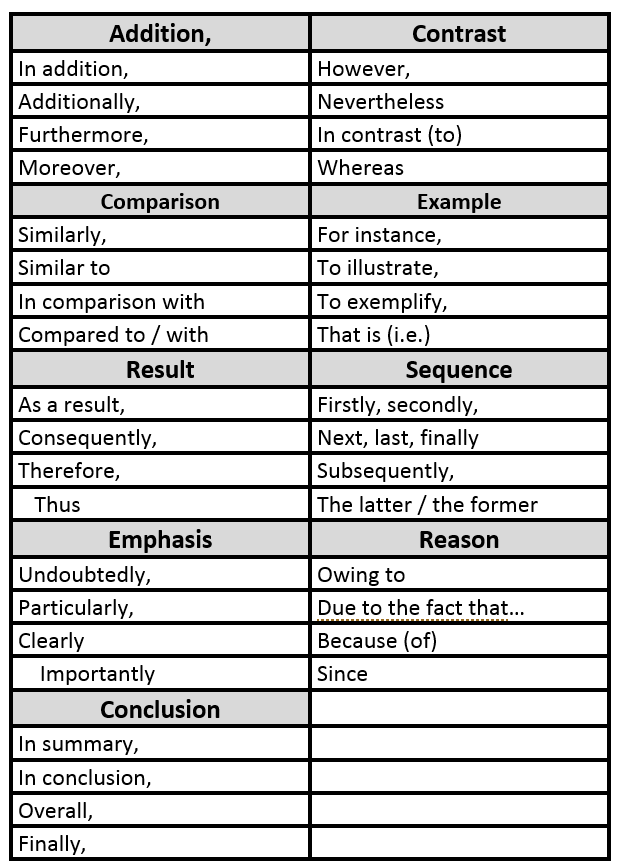
Linking Words Reference Sheet
Print off and give this to students as a helpful reference guide.
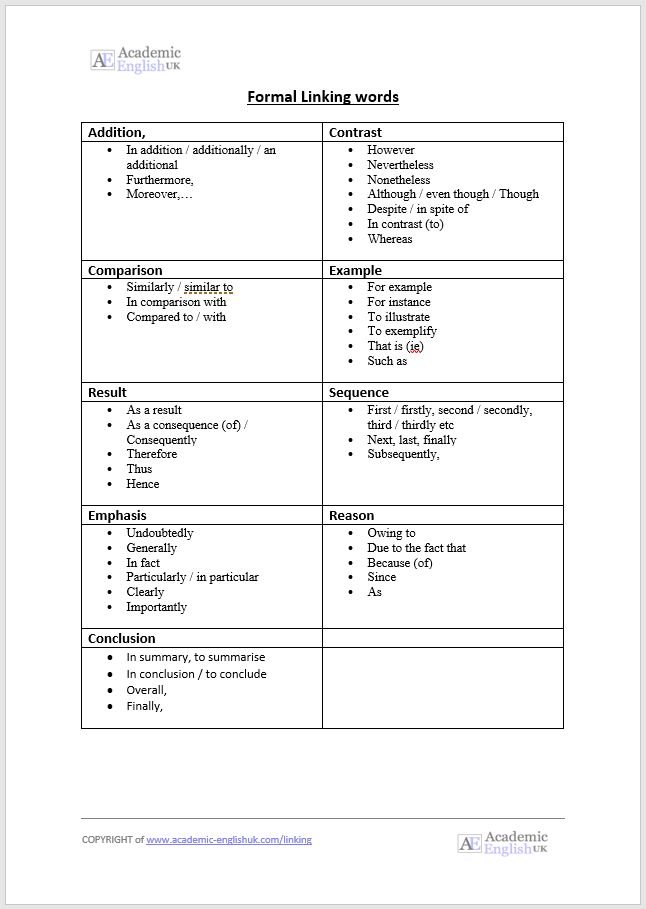
online resources

Medical English

New for 2024

DropBox Files
Members only

Instant Lessons

OneDrive Files

Topic-lessons

Feedback Forms

6-Week Course

SPSE Essays

Free Resources

Charts and graphs

AEUK The Blog

12-Week Course
Advertisement:.


50 linking words to use in academic writing
It’s very common for students to use long words they don’t understand very well in their essays and theses because they have a certain idea of what academic writing should be. Many students believe that academic writing is wordy and convoluted, and uses a lot of jargon. This leads many students to fall into a trap of imagining that the longer the word, the more impressive and intelligent their writing will seem.
We often see long sentences and multisyllabic words where shorter sentences and simpler words would do. Some students even use Microsoft Word’s thesaurus function to replace a common word with a more complicated word. This is a risky move, because unless you’re very careful, the new word may not carry quite the same meaning as the original, even if it’s similar.
The result can range from funny to confusing, which defeats the purpose of academic writing: to be as clear and concise as possible, using just the right words to convey your argument. Using uncommon words, instead of making your paper seem smarter, generally detracts from your ideas.
To avoid this, using linking or transition words that signpost your arguments can help to clarify your views and show the reader what to expect from certain paragraphs or sentences. These words give structure to the whole, helping you to organise your ideas and assist the reader in understanding them.
We have prepared some flashcards containing linking words you can use in academic writing.
CLICK HERE to download these FREE flashcards
Below is a handy list of words that are both useful and appropriate to academic language.
Describing similarities
Correspondingly
Not only… but also
In the same way
Showing cause and effect
Consequently
As a result
Hence (never ‘hence why’)
Since (try to avoid ‘as’ when showing cause and effect)
Accordingly
This suggests that
It follows that
For this reason
Comparing and contrasting
Alternatively
On the other hand
On the contrary
Showing limitation or contradiction
Despite/in spite of
While (not whilst!)
Nevertheless
Nonetheless

Emphasis, addition or examples
To illustrate
Further (not ‘furthermore’)
First, second and third (not firstly, secondly and thirdly)
For instance
In addition
To summarise
It can be concluded that
As can be seen
Given the above
As described
The best way to get better at writing academic language is to read academic writing. You’ll pick up all sorts of useful tips from published papers in your area of study.

Updated 31 January 2023 Ellen McRae, PhD, AE (IPEd), MNZSTI Senior Managing Editor
Request a quote
Please enter your details and we will email a quote to you.
- Enter the Word Count of your document *
- Comments This field is for validation purposes and should be left unchanged.
HELP: FORMATTING
- Choose 'leave formatting as it is' if you would like us to maintain the current formatting in your document. We will make sure it is neat and consistent.
- Choose 'I will upload the formatting guidelines' if you have specific instructions about formatting that need to be followed, for example, if you are submitting a thesis for editing and your university has specific thesis-formatting guidelines. Then, upload these guidelines when you upload your document for editing.
- Choose 'Elite Editing House Style' if you would like us to format your document according to our own guidelines, which have been specially designed to meet general university requirements.
- Choose 'APA 6th edition' if you want your document to be formatted according to the Publication Manual of the American Psychological Association (APA) 6th edition. APA formatting is designed specifically for draft manuscripts of journal articles and certain aspects are not appropriate for a thesis that is divided into chapters and is in its final form. If you are submitting a thesis we will modify APA style according to the preferred thesis style of most universities.
Editing guidelines
Please paste a link to the journal editing guidelines if possible.
Copyright 2024, Elite Editing
Terms & Conditions | Privacy Policy
- Academic Skills
- Reading, writing and referencing
- Writing effectively
Connecting ideas
How to connect ideas at the sentence and paragraph level in academic writing.
What is cohesion?
Cohesion refers to the way we use vocabulary and grammatical structures to make connections between the ideas within a text. It provides flow and sequence to your work and helps make your paragraphs clear for the reader.
Cohesive devices are words and expressions that show relationships between parts of text and ideas, such as cause and effect, time, addition, or comparison and contrast.
Watch the video to learn how to make your ideas link together and your narrative flow.
How can I create cohesion?
Let’s look at types of cohesive devices.
Linking words
Academic writing usually deals with complex ideas. To enable the reader to follow your thoughts, they need to be clearly and smoothly linked. To join ideas and sentences, we use a number of connecting words and phrases. For example:
Additionally, and, also, apart from this, as well (as), in addition, moreover, further, furthermore.
If, in that case, provided that, unless.
Correspondingly, equally, for the same reason, in a similar manner, in comparison, in the same way, on the one hand, similarly.
Alternatively, although, but, conversely, despite, even so, even though, however, in contrast, in spite of, instead, on the contrary, contrary to, nevertheless, nonetheless, notwithstanding, on the other hand, rather, still, though, yet, whereas, while.
Again, in fact, interestingly, indeed, it should be noted (that), more important(ly), most importantly, to repeat, (un)fortunately, unquestionably.
A further instance of this is..., an example of this is…, for example, for instance, such as, thus, as follows.
In other words, more simply, namely, simply put, to put it differently / another way, such as, that is.
A / the consequence of, because, due to, for, the effect of …, since, the result of …
Accordingly, as a result/consequence, consequently, for this reason, hence, so, therefore, thus.
Admittedly, although, clearly though, even though, however, indeed, obviously.
As a rule, for the most part, generally, in general, in most cases, normally, on the whole, usually.
First, second, third (etc), next, before, earlier, finally, following, given the above, later, meanwhile, subsequently, then, to conclude, while.
A note about presentation and style
Check a usage guide for exact rules for punctuation. Many introductory phrases have a comma after them. For example, 'therefore,' and 'in addition,'.
Referring backwards
To avoid repeating words and phrases many times, we use cohesive devices to make references to other parts of a text, such as:
- Pronouns: it, he, she, his, her, they, their
- Demonstratives: this, that, these, those
- Articles: a, the
- Adverbs: previously, subsequently
The Australian prime minister has called an early election. The date was selected to coincide with the start of the Olympic Games. This decision was based on the views of his ministerial advisors, who predicted that voter confidence in the government’s policies would be strong at this time . As previously mentioned , decisions on the timing of elections are based on predictions of voter confidence in the existing government.
In the example above:
- The date - refers back to the election date
- This decision - refers to the prime minister calling an early election
- His - refers to the Australian prime minister
- this time - refers to the start of the Olympic Games
- As previously mentioned - refers to all of the earlier information about the selection of election dates
Looking forward
We often use words and phrases to highlight new information for the reader. This helps make a smooth transition from one point to another. Such phrases include: the following, as follows, below, next, subsequently .
The following dates have been proposed for the forthcoming election: September 8, September 15 and 3 October.
The next issue to be discussed is the influence of the media on voter confidence in the government.
Connecting paragraphs
Apart from using the linking words / phrases above, showing the link between paragraphs could involve writing ‘hand-holding’ sentences. These are sentences that link back to the ideas of the previous paragraph. For instance, when outlining the positive and negative issues about a topic you could use the following:
Example (from beginning of previous paragraph):
- One of the main advantages of X is…
When you are ready to move your discussion to the negative issues, you could write one of the following as a paragraph opener:
- Having considered the positive effects of X, negative issues may now need to be taken into account…
- Despite the positive effects outlined above, negative issues also need to be considered...
It is always important to make paragraphs part of a coherent whole text; they must not remain isolated units.
Checking for paragraph links in your own work
When you are editing your next written assignment, ask yourself the following questions as you read through your work (Gillett, Hammond, & Martala, 2009):
- Does the start of my paragraph give my reader enough information about what the paragraph will be about?
- Does my paragraph add to or elaborate on a point made previously and, if so, have I made this explicit with an appropriate linking word / phrase?
- Does my paragraph introduce a completely new point or a different viewpoint to before and, if so, have I explicitly shown this with a suitable connective?
- Have I used similar connectives repeatedly? If yes, try to vary them using the above list.
Strategies to improve cohesion
- Select a piece of writing, preferably from a textbook or journal article, from your area of study.
- Choose a paragraph and underline or highlight all the different forms of cohesion used, such as using linking words, referring backwards, looking forwards or adding synonyms.
- Which forms are the most common?
- Choose a couple that you think are effective and practice using them in your own writing.
- Try to use a variety of ways to show the relationship between your ideas.

Looking for one-on-one advice?
Get tailored advice from an Academic Skills Adviser by booking an Individual appointment, or get quick feedback from one of our Academic Writing Mentors via email through our Writing advice service.
Go to Student appointments

Writing: flow and coherence

Making your essays clearer
Improve your work and make your assignments easier to understand with clear writing
Writing clearly and structuring your assignments can help make your work clearer and improve your grades.
Writing clearly involves using good sentence structure and using connectives to link your ideas. Using connectives properly makes your work easy to read and understand, but using them unnecessarily can confuse readers.
Language choices
Different assignments in your degree may need different styles and encourage different word choices. Your university assignments will usually use an academic and formal style. You should choose your words carefully to demonstrate your point clearly and succinctly.
Tips to improve word choices in your writing:
- learn your subject’s technical and theoretical terms – this won't happen overnight and will continue throughout your degree
- don't use fancy words and phrases just to sound more academic – make sure you understand a word or phrase and how to use it first
- avoid using a thesaurus – there are very few exact synonyms in English and some terms have very specific meanings in particular fields (particularly for technical and theoretical terms)
Connectives and transition signals
Connectives link sentences, phrases and ideas in your writing to guide your reader through your work. Transition terms are a type of connective that specifically indicates some kind of change or development.
Connectives can demonstrate your analysis and criticality, the flow of your work, the development of your material, or a different angle or change in direction.
Connective examples:
- The first claim, [topic] can be explained by…..
- For example...
- However; in contrast; on the other hand...
- Nonetheless; despite this; although...
- In addition; furthermore...
- Therefore; consequently; as a result...
- Similarly...
Appropriate assertion
Avoid stating that something is 'definite' in your work because you probably can't explore all potential outcomes of the statement in your essay. Use academic caution to suggest conclusions in your writing, and avoid terms like 'obviously', 'undeniably', 'certainly' and 'definitely' (unless you're quoting someone else).
Instead of using casual terms like 'surely' or 'everybody knows', you should use phrases like 'It is common knowledge' or 'It is generally accepted...'.
You could use these phrases:
- This shows...
- It is evident that...
- It is therefore possible to conclude that...
- The argument strongly suggests that...
- This is supported by...
- This demonstrates...
Cautious language
Academic caution is about not making absolute statements of fact.
Example of cautious language:
- Seems to; tends to; looks like; appears to show; indicates; could be seen as...
- Thinks; assumes; believes; suggests...
- May; might; could; perhaps...
- Probably; possibly; perhaps; conceivably...
Challenging arguments
You can express doubt about or challenge your evidence, an argument, or a claim in your resources. You can also express doubt about something you've said.
Five examples of phrases to express doubt:
- It is possible that this means...
- This could indicate that...
- The argument is plausible because...
- This claim is debatable because...
- Therefore, it is an implausible argument...
Using evidence
Evidence can come from a range of sources. Your field will have specific requirements and reputable sources. Your evidence could come from data, results, findings, newspapers, databases, documentaries, or sound logical thinking and argument.
Examples of phrases to introduce evidence:
- The evidence shows...
- Table 1 demonstrates...
- Figure 2 indicates...
- According to the results...
- The argument suggests...
- The author implies that...
Remember that writer implies something, and the reader infers something, when making your word choices.
Expressing what comes first or is most important
When you need to highlight a key point in your word you could use phrases like:
- The primary issue...
- The key point...
- The principal argument...
- The main point...
- First, this essay will...
Expressing sequence
Your reader should be ware of where they are in your work. It's easy to lose your place when reading extended writing so you should include some guidance in your assignment. Expressing sequence also demonstrates that you're thinking logically and systematically to present your points or argument, and keeping in touch with how elements relate to each other.
Examples of terms to express sequence:
- Previously...
- Secondly...
- Furthermore...
- Subsequently...
- In addition...
- Moreover...
Expressing finality
Your conclusion will usually summarise the information in your essay. You can use terms like:
- Ultimately...
- In conclusion...
Download our writing flow and coherence revision sheet
Download this page as a PDF for your essay writing notes.

Basic essay structure

Paragraphs main body of an assessment

Writing clear sentences
- Learn English
- Infographics

- English Grammar
Linking Words: List of Sentence Connectors in English with Examples!

Struggling to connect ideas? ‘Connectors in English’ have your back. Connect, express, and impress – all with Connectors in English!
Connectors Definition
Linker Words or Word Connectors are used to link large groups of words: phrases and sentences . You can also use them to connect paragraphs to give them coherence. Sentence connectors are usually placed at the beginning of a sentence and may be categorized as follows:
- This restaurant has the best kitchen in town. However, their staff are quite rude.
2. IN CONTRAST
- House prices have gone up this year. In contrast, car prices seem to be stagnating.
3. NEVERTHELESS
- I was in so much pain I didn’t want to get up in the morning. Nevertheless, I went to football practice as usual.
4. NONETHELESS
- I don’t think Sean has serious behavioural problems. Nonetheless, I’ll talk to him first thing in the morning.
- I’ve asked you a thousand times not to leave your dirty socks on the floor. Yet, you keep doing it.
6. ON THE OTHER HAND
- England has the best language schools. On the other hand, it has the worst weather.
7. BY COMPARISON
- Going out with Jim has its risks. By comparison, being with Tim is as easy as falling off a log.
8. ON THE CONTRARY
- I don’t hate Jim. On the contrary, I’m rather fond of him.
- I didn’t want to take a side in the argument. Instead, I put my headphones on and listened to some smooth jazz.
10. IN ANY CASE
- I was thinking of going round Jim’s place. In any case, I haven’t been invited.
11. ALL THE SAME
- Yes, he’s very good-looking. All the same, I don’t think you should go out with him.
Read more: Other ways to say ON THE OTHER HAND!
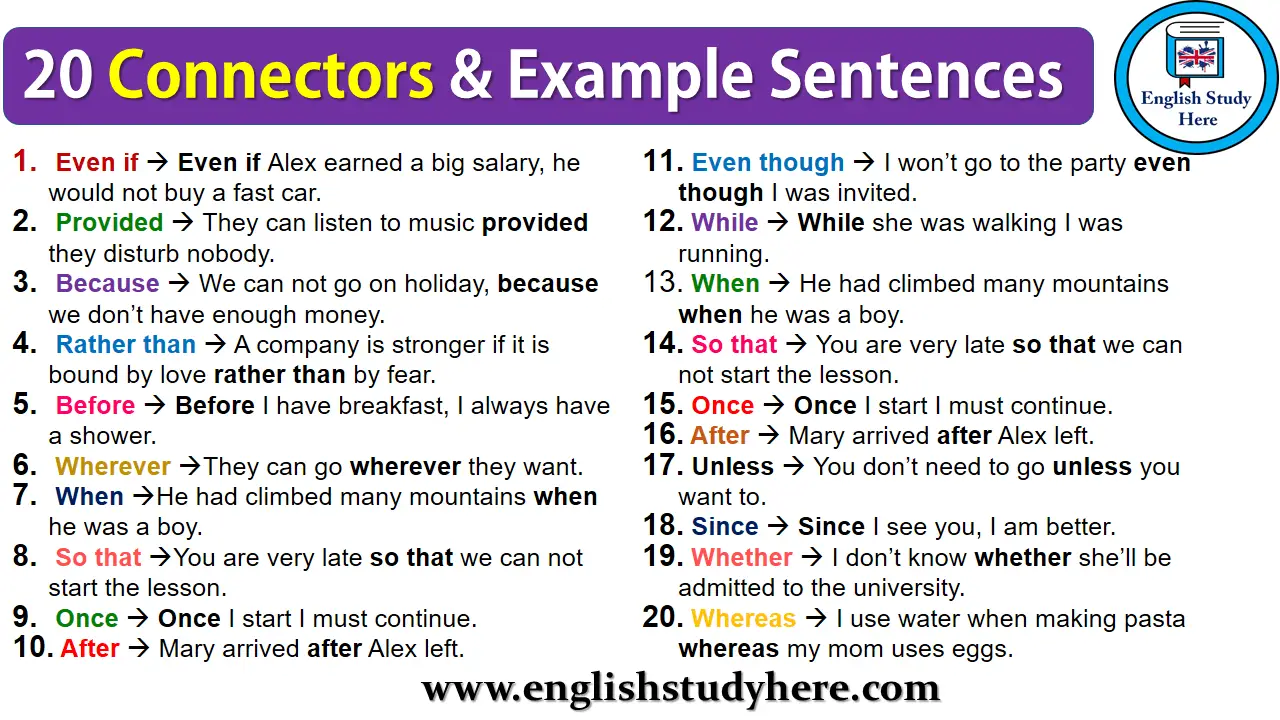
👉 SIMILARITY
1. LIKEWISE
- You can’t give your phone number to every man who asks for it. Likewise, you can’t go out with everyone who fancies you.
2. SIMILARLY
- You’re not allowed to use your phone here. Similarly, you have to switch it off when you’re in the library.
3. CORRESPONDINGLY
- She’s an excellent photographer. Correspondingly, her paintings are works of art.
4. IN THE SAME WAY
- Cutting down on sugar will help you lose weight. In the same way, doing more exercise will help you get rid of a few kilos.
- I want to talk to Prince Harry when I’m in England. Also, I want to meet his sister-in-law.
Read more: Difference between COMPARED TO and COMPARED WITH
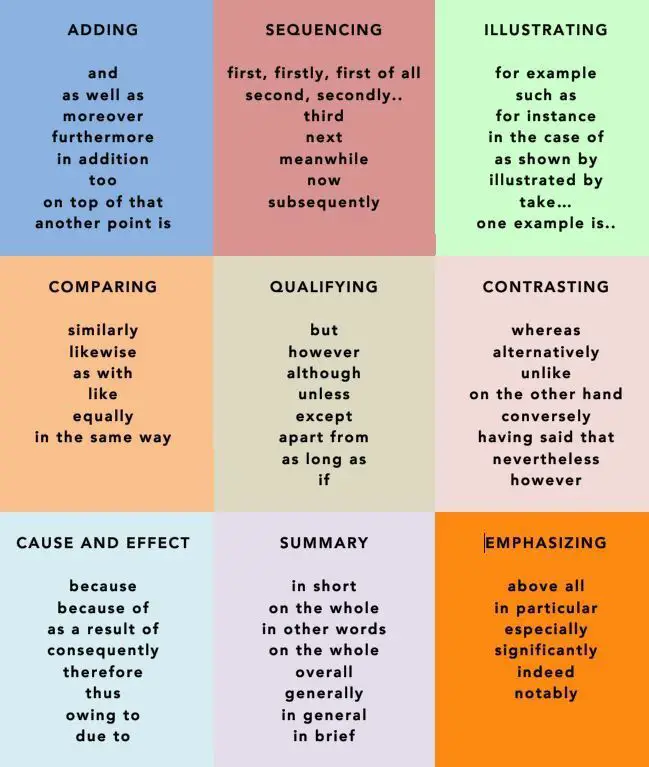
1. AS A RESULT
- I’ve done a pranic healing course. As a result, I’ve been able to cure my neighbour’s sick cat.
2. AS A CONSEQUENCE
- Zack has skipped school on many occasions. As a consequence, he’s failed his French test.
3. THEREFORE
- We’re going to experience some meteor showers in the next few days. Therefore, the number of miraculous self-healings will rise.
- You didn’t tell me you wanted to come. Thus, we won’t be taking you with us.
5. ACCORDINGLY
- Plenty of tourists visit the area in summer. Accordingly, selling hand-made objects is the main source of income for locals.
Read more: 6 Ways to Improve Your English Writing Skills

👉 SEQUENCING
1. FIRST, FIRSTLY, FIRST OF ALL, IN THE FIRST PLACE
- First of all, I’d like to talk about the benefits of having a pet pig.
2. TO BEGIN WITH
- To begin with, pet pigs are cleaner than dogs.
3. FOR ONE THING
- For one thing, they’re completely loyal to their owners.
4. SECOND, SECONDLY, IN THE SECOND PLACE
- Secondly, their impressive numeracy skills must be mentioned.
5. FOR ANOTHER THING
- For another thing, you might want to consider how cute they look in pyjamas.
6. THIRD, THIRDLY, IN THE THIRD PLACE
- In the third place, you can always count on your pet pig to perform some tricks for you when you’d like to impress a pretty girl.
- Also, they don’t eat much.
- Besides not eating much, they won’t ever chew on your electric cords.
9. IN ADDITION
- In addition, they can be taught to feed themselves if you allow them access to your pantry.
10. FURTHERMORE
- Furthermore, they make wonderful walking buddies.
11. MOREOVER
- Moreover, they’ll show you the way home when you’re drunk.
12. FINALLY
- Finally, pet pigs are fantastic guards. No burglar would ever have the heart to hurt a pet pig.
13. LAST, LASTLY, LAST OF ALL
- Lastly, your reputation as an eccentric will rapidly grow in the neighbourhood if you’re seen walking a pet pig on a leash every morning.
Read more: 18 Powerful Websites to Improve Your Writing Skills in English

👉 ORDER OF IMPORTANCE
1. MOST IMPORTANTLY
- I’d like to talk to you about how to keep calm at your workplace. Most importantly, never go to the canteen while your boss is there.
2. PRIMARILY
- You’ll have to focus on your immediate surroundings. Primarily, on your computer screen.
3. ABOVE ALL
- Above all, don’t ever look up from your notes when people are around.
4. MOST SIGNIFICANTLY
- Most significantly, avoid eye-contact at all costs.
5. ESSENTIALLY, BASICALLY (usually spoken)
- How can I put this? Essentially, having an affair with one of your colleagues should be the last thing on your mind.
Read more: 7 Special Apps To Quickly Improve Your Typing Speed
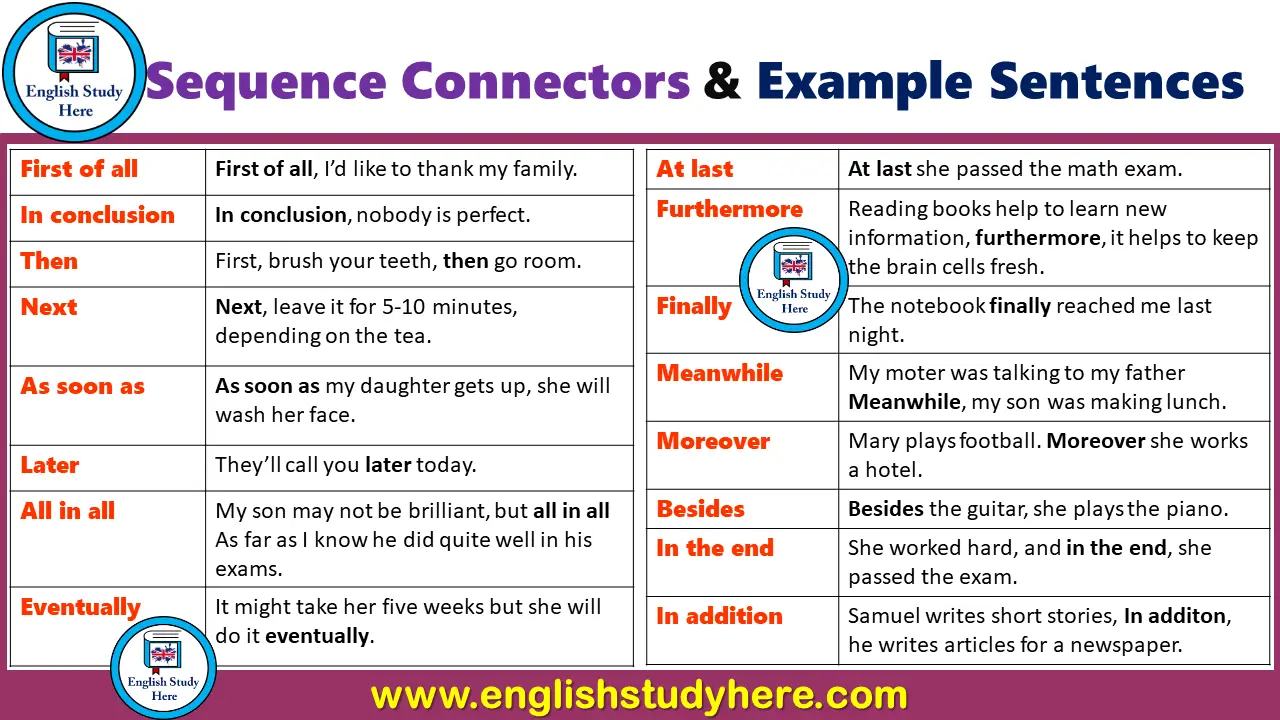
👉 PARTICULARIZATION
1. IN PARTICULAR, PARTICULARLY
- Nearly a third of marriages end in divorce. In particular, it’s middle-aged couples that yearn for much more from life.
2. MORE SPECIFICALLY
- Couples tend to argue about financial issues. More specifically, they argue when one of them is out of work.
Read more: How Many Types of Expressions there are in English?
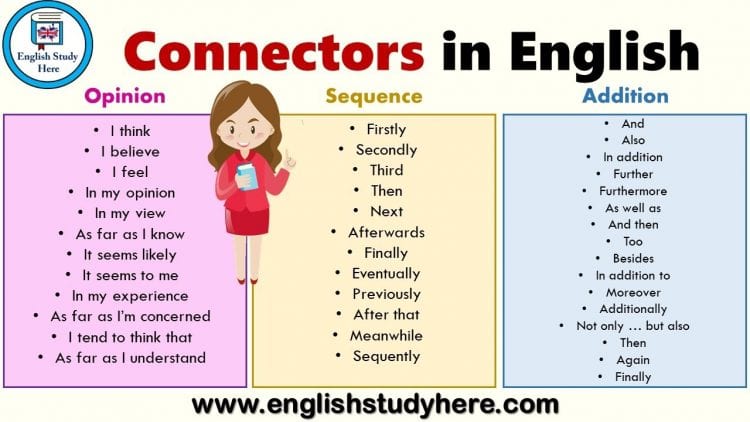
👉 EXAMPLIFICATION
1. FOR EXAMPLE
- To solve this problem, you might want to try making small gestures. For example, making your spouse’s favourite meal for dinner or giving him a massage after a tiring day.
2. FOR INSTANCE
- Appreciate the small things your spouse does for you. For instance, leave thank-you notes for them every now and then.
3. TO ILLUSTRATE
- Misunderstandings can be highly destructive. To illustrate, if your spouse sees you with a friend of the opposite sex in a café, he might not understand why he hasn’t been invited and demand an explanation.
Read more: Other ways to say for example?
👉 EXPLANATION
1. THAT IS TO SAY, THAT IS
- Keep romance alive. That is to say, don’t let your lovelife fall into routine.
- I have a very good reason for not trusting my ex. Namely, he’s a convicted felon.
3. IN OTHER WORDS
- Don’t be unsociable. In other words, go out and make some friends.
4. PUT DIFFERENTLY
- John has managed to get over Jane. Put differently, he’s started seeing other women.
Read more: 10 Common English Expressions with Explanation (Video)
👉 EMPHASISING
1. AS A MATTER OF FACT
- I love sleeping with my pet pig. As a matter of fact, I can’t fall asleep unless he’s in my bed.
- I told them not to invite Rachel to the party. In fact, I was the only person who saw what a party pooper she really was.
3. ACTUALLY
- I think it would be a good idea to send her some flowers. Actually, you should get her a hundred orchids.
- He may be the best-dressed man around. Indeed, he has a really good taste in fashion.
Read more: Essential Academic Writing Examples and Phrases!
👉 FOCUSING AND LINKING
1. AS FOR (often suggests disinterest or dislike)
- I’m going to Janet’s party at the weekend. As for Mary’s, I think I’ll pass.
2. WITH RESPECT TO
- Starting your own IT company may be the one of the best things you can do right now. With respect to opening a pet shop, it’s hard to say the same thing.
3. REGARDING
- Start your day with making the most important phone calls. Regarding emails, you might put them off until later.
4. WITH REGARD TO
- With regard to handling complaints, you might want to keep in mind that your customers are always right.
5. AS REGARDS
- Working from home has many advantages. As regards disadvantages, it might be difficult to keep your cat off your keyboard.
6. TALKING OF
- Talking of cats, you can’t trust them to keep you company when you need it. They’re quite selfish creatures.
7. AS FAR AS … CONCERNED
- As far as dogs are concerned, they might give you a chance to get up from your desk and get some exercise during the day.
Read more: English Grammar: Sentence Structure in English

👉 CONCLUSION
1. IN CONCLUSION
- In conclusion, it may be said that pigs make the best pets.
2. IN BRIEF
- Meeting my boss at the pub was an interesting experience. In brief, it was a disaster.
3. IN SUMMARY
- In summary, it may not be the best idea to frequent the same pubs as your boss.
4. TO SUM UP
- To sum up, some people are better suited to working from home than others.
5. ALL IN ALL
- All in all, you have to make sure both you and your customers are satisfied with your work.
Read more: What are the other ways to say in conclusion ?
👉 CORRECTION
- I thought it was a good idea to get a ferret. Rather, it had always been my dream to get one.
2. TO BE MORE PRECISE
- You might want to change a few things. To be more precise, I think you should start again from scratch.
Read more: Best English Grammar and Spelling Checkers Online
1. AT FIRST
- It wasn’t a piece of cake to learn English. At first, I couldn’t pronounce all the words correctly.
- Then, I couldn’t spell all the words correctly.
3. AFTERWARDS
- Afterwards, I had a hard time understanding the tenses.
- Later, I couldn’t memorize phrasal verbs and idioms.
5. IN THE MEANTIME
- In the meantime, I was getting some help from MyEnglishTeacher .
6. MEANWHILE
- Meanwhile, I was enjoying my skype lessons more and more.
Read more: A Visual List of 100 English IDIOMS FOR TIME with Examples
👉 DISMISSAL
(of what was said before)
- I couldn’t get my head around the Passive Voice. Anyway, I don’t think it’s important to use it all the time.
- Anyhow, I’ve just decided to learn Russian next.
3. AT ANY RATE
- At any rate, I don’t want to become a simultaneous interpreter in five languages.
Linking Words Quiz › TEST YOURSELF
- Soon / After
- Now / Later
- Firstly / Secondly
- Before / After
- As a result
- Accordingly
- Along those lines
- In other words
- Nevertheless
- All the same
- On the other hand
- On the other side
- Furthermore
- Subsequently
- On top of that
- Despite this
- In particular
- To begin with
- In the back
- In contrast
- At any rate
- As far as / concerned
- As for / treated
- However / asked
- As far as / thinking
- For one thing
- Likewise / equally
- Just as / so too
- Another / like
👉 Connectors Synonyms
Connectors are not only used in grammar . Connectors are things that are used to connect or tether two, or more, things together. There are many different synonyms for connectors:
- Bond, coupling, joint, link, adapter, clamp, fastener, junction, tie, terminal, plug, fitting, splicing, fastener, sleeve, etc.
👉 Sentence Definition
A sentence is a set of words that forms a coherent and complete thought and message. This means that a sentence says something concrete. It has to be structured and logical in order for the sentence to be correct.
Sentences are made up of various parts , such as: nouns, verbs, adjectives, pronouns, articles, etc. Within a sentence, there are parts that relate the thought and message , such as: subject, predicate, object, phrase, punctuation, etc. Each of these parts is important for a sentence to be complete.
Through sentences we tell other people what we think, feel, or what we want to do . In order to relate those thoughts we string together words into groups. These finally relate our message to other people and the world.
There are four different types of sentences , and each has its own specific goal and structure. These types are: declarative, imperative, interrogative, and exclamatory.
RELATED ARTICLES MORE FROM AUTHOR

Complex Sentences and Compound Complex Sentences in English

50+ Best Online Quiz Makers for You!

Examples of Silent Letter L

Find the Perfect Film for your Mood with our “What Movie Should I Watch” Quiz!
![Spot Parts of Speech [Grammar Quiz] parts of speech quiz](https://www.myenglishteacher.eu/blog/wp-content/uploads/2023/01/parts-of-speech-quiz-218x150.jpeg)
Spot Parts of Speech [Grammar Quiz]
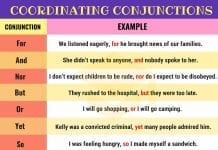
FANBOYS GRAMMAR 😃🥳😜 7 Coordinating Conjunctions with Examples

One of the best posts I’ve ever read here. Congrats!!
It’s awesome so useful and practical thanks a million. I’m gonna share it with my friends.

I liked it so much. Thank you Mr/Mrs tutor.

Indeed, it refreshing our vocabulary

Thank you very much!! This must be by far one of the greatest post I’ve seen to improve my writing skills and expand the vocabulary of connectors. Therefore 😉 , I will add to my list of resources and share with my friends
So glad! 😃❤️

Thanks a ton, teacher!
Sure, anytime!

Thankyou soo muchhh for this usefull info..

Thank you so much for this useful

Excellent exercise
My great thanks
It is highly appreciated

Thanks a lot
you are welcome!

Helpful post! You have nicely divided all the connectors in group like result, time, explanation, conclusion …. and present them with accurate examples. Everything is easy to grab. Thanks for sharing this rare post.
Thank you so much Mohan! I’m glad you loved it!

Thanks for this usefull lessons. They are highly educattive.
Thank you so much!

So far this is the best post I’ve ever seen. I find it hard to use those connectors in statements. I can speak basic English and sometimes not concise with my statements because I’m not good in using connectors in English. Thank you for this great post. It will help a lot of speakers to become articulate with the language.
Thank you so much Oscar for your feedback!

Thanks millions for posting the tables of connecting sentences. Have a great life

I love this array of connectors. Great selections to fit our lesson. Thank you to all who are part of this website and contributors. God bless you all!
Thank you so much Mica.

Linker words, also known as sentence connectors, play a crucial role in connecting phrases, sentences, and paragraphs for enhanced coherence in writing. In terms of contrast, words like “however,” “in contrast,” and “nevertheless” emphasize opposing ideas. For expressing similarity, “likewise,” “similarly,” and “correspondingly” are effective. Result-oriented connectors include “as a result,” “therefore,” and “accordingly,” signaling outcomes or consequences. These words help create a logical flow within text, ensuring a smooth transition between ideas. Whether highlighting differences, similarities, or results, these connectors contribute to cohesive and well-structured writing, facilitating the comprehension of complex information.

Its very useful , thank you.
Thank you so much Himali!
MOST POPULAR

👉 A BIG List of Prefixes and Suffixes and Their Meanings

200 Phrases for saying THANK YOU in any situation!

Formal and Informal Email Phrases – from Greetings to Closing Phrases!

80 In Conclusion Examples! + Translation

90 Names of Baby Animals and Their Parents
![Types of Adverb 🦠 Adverb Examples [All You Need] adverbs](https://www.myenglishteacher.eu/blog/wp-content/uploads/2018/07/adverbs-100x70.jpg)
Types of Adverb 🦠 Adverb Examples [All You Need]

Talk to Strangers / Free Chat Rooms

English Level Test

6 Ways to Immediately Improve Your English Communication Skills

50 Creative Ways to Say Happy Birthday: My Top Picks

What does TBH mean? (TBH full form) on Facebook, Instagram, Texting

25 Ways to Say “Keep Up The Good Work” 💪 &...
Stay connected, editor picks.

Supposition Meaning

Summary of how Components of Health are related to Wellness

Understanding the Extroverted Introvert
Popular posts, popular category.
- Q&A 2439
- English Vocabulary 624
- English Vocabulary Dictionary 363
- English Grammar 200
- Synonyms 147
- Infographics 109
- Collocations 105
- Learn English 81
- English Idioms 69
- Privacy Policy
- Terms & Conditions
- How it works
- Top Writers
- TOP Writers
How to Connect Ideas Properly in Essay Writing?
Each paper should feature a logical connection between paragraphs and sentences. This is to establish a comprehensive coherence and guide your reader from one section to another preventing from getting lost in author’s thoughts. While research papers and simple types of essay do not require such connection, it appears to be vital for such academic assignments as an argumentative essay . Follow our useful writing tips and boost your academic progress.

Tips on connecting sentences
The only way to establish a proper sentence connection is to use special words. They typically include:
- And – the word can be transformed into more complicated links like furthermore, additionally, as well as and other constructions;
- But – the main mission here is to provide an alternative in a logical way. You may use such transformations as although, despite, in contrast, nonetheless, etc.;
- So – this word, as well as its alternative forms, is to provide a result or effect. For this reason, the water starts boiling. Therefore, greenhouse effect causes air pollution;
- Because – the word highlights the effect or the cause. It stresses the reason. The result of 1005 degrees is boiling water.
Make sure you follow necessary grammar and punctuation rules when using those words to link sentences in your paper.
Tips on connecting ideas
This one is probably the toughest challenge for immature and amateur writers. Using the write sentence formation is vital. At the same time, each part of the paper should have logical links to guide readers from one thought to another. Here are some useful tips not to get lost:
- Simplify the issue – do not be afraid to explain your thought in a simpler manner using “in other words” or other forms;
- Stress Similarities – compare a complicated thought with a simple analog. “In the same way as”, “equally” and other collocations would come in handy;
- Provide the Examples – give simpler examples to more complicated issues;
- Display Emphasis – use words that will stress your emphasis. They may include such collocations as “more importantly”, “indeed” and others.

Tips on connecting paragraphs
After we have provided a proper link to sentences and ideas, it is high time we connected our paragraphs to make the paper look complete. Signal and pointing words appear to be extremely useful for this purpose:
- Use Signal Words – use collocations to signalize a reader about the end of the beginning of the paragraph. “Besides”, “even though” and other signal phrases are necessary;
- Time Signals – they have proved to be rather effective. They include strong words and phrases like “finally”, “meanwhile” and others.
Writing a good paper means not just expressing your knowledge of the topic. It is also about great writing style and skills. For this reason, you need to establish strong connections between thoughts and ideas, paragraphs and sentences. Never leave your reader lost in thoughts. You should guide him or her using signal words and other phrases to spread light on your major paper.


- --> --> Search --> --> --> --> --> --> -->